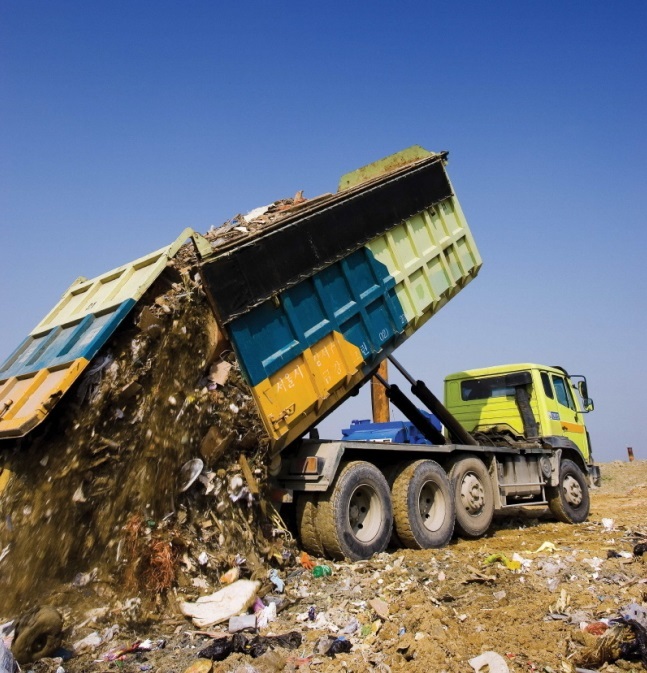Having experienced rapid economic growth in the past few decades, Korea has proactively implemented recycling-oriented measures against the growing waste.
The government implemented waste schemes during industrialization in the ’60s and ’70s, and in 1992 it began to actively push for recycling under the recycling promotion act.
The state set legal limits on the use of packing materials and disposable products; imposed waste fees on manufacturers that make unrecyclable products; and provided support for the recycling industry.
The regulation also included introducing a deposit refund system, which returns a deposit to the waste-generating companies once they collect back their waste. The rule targeted six types of industries — food, detergents, batteries, tires, electronics and lubricants.
 |
| A waste truck dumps unrecycled trash at a landfill in Incheon. (Sudokwon Landfill Site Management Corporation) |
Along with the recycling promotion law, the government initiated a volume-based disposal system in 1995 to encourage waste sorting and to cut down on garbage by charging citizens based on the amount of waste they throw out.
All trash must be disposed in state-authorized plastic bags that are available at local stores. The price differs according to municipality and district, with Seoul City levying 413 won per 20 liters of trash on average. Busan imposes the highest rate, at 813 won per 20 kilograms as of now.
The system sharply reduced household waste, as the daily trash amount dropped by about 10,000 tons to some 49,000 tons on average in 2013, compared to 1994, according to the Environment Ministry. This is equivalent to one person generating 0.94 kilograms of trash per day on average in 2013, which is down 360 grams from 1994, the ministry said.
Starting from last year, the government also initiated a volume-rate disposal system for food waste. Each citizen pays according to the volume of their food waste measured by three types — plastic bags, RFID reader or electronic chips. Collecting food waste was discretionally run by municipal offices for years until 2013. Most of the food waste is recycled as animal feed.
In a bid to expand the product-makers’ recycling participation, the state revised the deposit refund system to the “Extended Producer Responsibility” system in 2003. The new scheme aimed to induce manufacturers to pursue greener choices during the entire production process from designing to disposing the product.
Under the system, the Environment Ministry allocates a certain recycling quota to each industry every year based on the production level and waste management. If one fails to achieve the recycling goal, the company is fined.
The push for the EPR system had a drastic impact as the recycling rate among the industries under the regulation surged by 64 percent to 1.54 million tons in 2013 from 2002.
Thanks to such recycling measures, over 83 percent of the overall generated waste is being recycled as of now, with the rest either getting buried in the landfill site or incinerated, the ministry said.
To further raise the recycling rate, the government expanded the recycling drive to the vehicle and metal industries in 2008 with a new rule that encourages them to reuse old cars, and replace natural metals with recycled ones for raw materials.
In addition, the government has been moving to boost the trade of recyclable resources by connecting waste suppliers with recycling companies through an online market or mobile application starting last year. Individuals can take part in the market as both buyers and sellers.
As of December last year, over 100,000 subscribed to the market service, making about 750,000 deals, the ministry’s data showed.
The ministry is now seeking to use the waste as an energy source, with a particular focus on converting the combustible waste into solid recovered fuel.
While only 1.5 percent or 58,000 tons are currently utilized as an energy source due to the lack of facilities and technology, the government is aiming to use 90 percent of the combustible waste as an energy source by 2020, which is equivalent to 3.4 million tons a year.
Although the government is stepping up these green initiatives, the country also faces persistent conflicts over managing waste that is not recycled, especially over using the limited landfill space.
Earlier this year, Seoul City, Incheon and Gyeonggi province were embroiled in a controversy over extending the use of a landfill site in Incheon.
While the site was originally expected to become full and set to close by the end of next year, Seoul City and Gyeonggi Province asked Incheon to extend the period as the site was only half-full.
About 48 percent of trash dumped daily at the Incheon landfill is from Seoul, while another 34 percent comes from Gyeonggi Province and the remainder from Incheon. Incheon at first rejected the demand, citing residents’ complaints, but later agreed to extend it by 10 years in return for the handover of the land ownership worth 1.8 trillion won ($1.6 billion) and the right to collect waste commission fees worth 120 billion won a year.
By Lee Hyun-jeong (rene@heraldcorp.com)

